NPDES permits were established under the Clean Water Act; this act that’s our Congress passed in 72 and it’s had a number of different changes along the way. But really what it was trying to do is, everybody’s heard about the Rivers on Fire where one caught on fire and that’s been used as the example and then we’ve had a lot of environmentalist that come along and have had a lot of impact on trying to get some of the regulations passed. We had the EPA that developed in 1972 which was after that and so in that the Clean Water Act was really trying to look at reducing a number of discharges of pollutants to our water systems and specifically it focused on point sources. So NPDES stands for National Pollutant Discharge Elimination System, obviously were trying to eliminate those discharges so that was the point of it. So what that governed, is that governed to different areas called MS4’s and so the non-point and point sources. So we have that point source I was just mentioning, we also have something called non-point sources which are more distributed.
MS4’s stands for Municipal Separate Storm Sewer System, again our government really likes to use these acronyms, MS4.
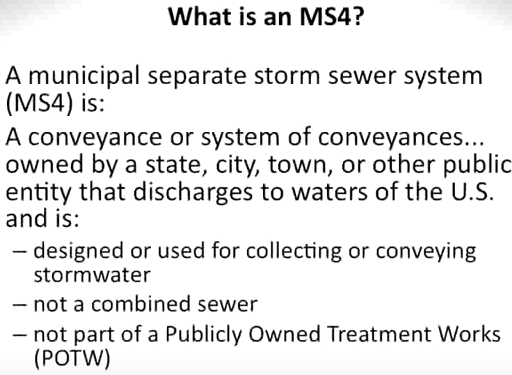
And it is dealing with conveyance systems, it’s typically deals with municipalities but the Denver Federal Center actually is an MS4, it’s a non traditional MS4 and so they get their own permit. Other nontraditional types of entities are universities, so like DU and CU those are nontraditional MS4’s that get their own permits. Really what they’re trying to do is permit these areas so that they can regulate the discharges and try to prevent the pollutants getting to the rainwater. They are not a combined sewer. We don’t have too many combined sewers but we do have one here in Denver but we don’t have too many of those in this area or out West. They are typically back east and not part of a POTW or Publicly Owned Treatment Works. Everybody recognizes that map of the facility.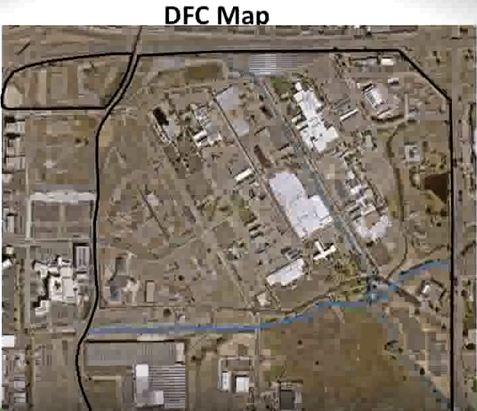
Here the Denver Federal Center and its receiving waters the McIntyre Gulch and the Ag Ditch, which is technically receiving water as well. Both the McIntyre Gulch going across and then the Ag Ditch coming from North to South t; there is one coming in from the South to North to McIntyre called the Welch Ditch. We’re treating The Welch Ditch as a MS4 here and we do have these receiving waters that we have to be aware of. These NPDES permits they have all these requirements.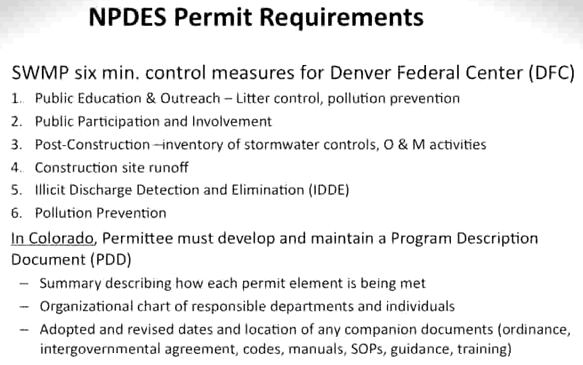
This facility has to develop a rainwater management plan and it has to address each one of these items. So the permit; we go through and talk about the different public education and outreach, this is actually a part of that public education outreach, this training. We have to talk about public participation involvement etc. through all of this stuff and we’re going to hit on some of this in this presentation. And then there are some specifics that have to do with what Colorado needs. There’s program description documents that’s essentially what our rainwater management plan here does.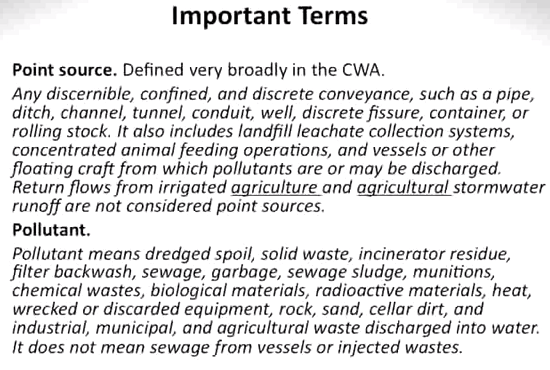
Any discernible, of course the government likes to use a lot of words to describe these things because they’re quite broad but yet they need to be specific for when they get challenged in court. It includes all of this; discernible, combined and discrete conveyance such as a pipe, ditch, channel, tunnel, conduit, well, discrete fissure. That’s probably a challenge sometime to include that language in their etc. It’s really any discharge that has a place where you can determine where it came from. Although returns flow from agriculture and agricultural rainwater runoff are not considered point sources. Point source, you can usually determine where it’s coming from non-point source it may be hard works and agricultural source.
Pollutants are defined very broadly dredged spoil, a lot of people don’t think that that dirt that we just dug up and we put on the street is a pollutant; it is. Solid waste, incinerator residue has all the definitions there, so it has a real broad definition of what pollutants can be.
A lot of people don’t realize that even warm water, so water that’s rainwater for instance that hits the street, we know that during the summer like last year when they had 105° out there and it’s hot that water when it gets warmed up is now is considered a pollutant.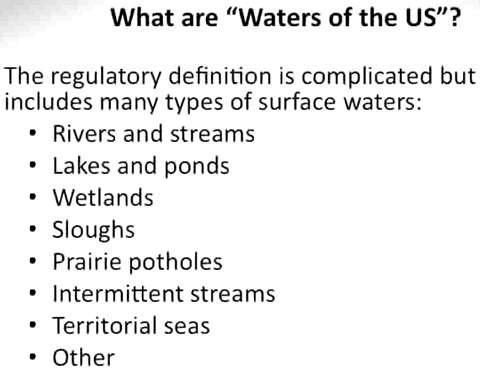
All these are regulated by waters of the US that again is a very broad definition it includes the list up here but guess what that includes agricultural ditches and some streams that even have intermittent flow. Even though they are often considered fishable and swimmable so it might have intermittent flow as well. Intermittent streams are included up here, territorial seas we have those covered under waters of the US.
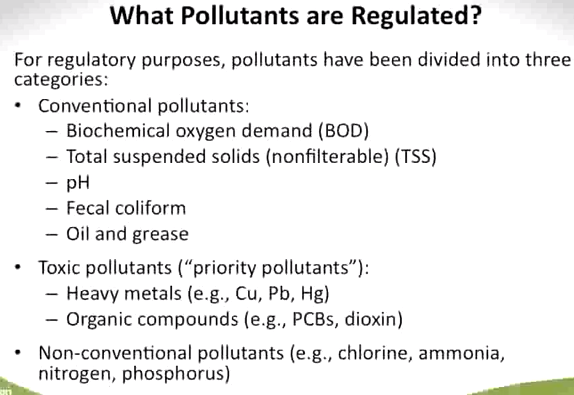
What pollutants are regulated? This is just an example of different pollutants, so we have these conventional pollutants and we’ll get into a little bit of these and then toxic pollutants and then non-convention of pollutants like nitrogen or phosphorus which are used in fertilizers for instance.
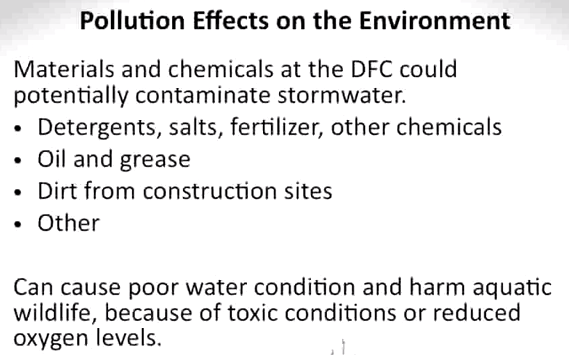
Pollutant effects on the environment, we know that we’re calling it a pollutant already so it probably has some issues with what it does in the environment. So detergents, salts, fertilizers I had mentioned those. The big thing is that they can cause poor water quality conditions and harm aquatic wildlife; a lot of us like to go fishing in different places in the reservoirs etc. When we’re getting our rainwater runoff or were putting or fertilizer on our yards and so forth and that ends up running off because it got on to the sidewalk or it got into the street or something like that; where does that go? It goes to our waterways because that’s where their draining our stuff. Well it has an effect when it gets there, warm temperature can warm the waters the nutrients for instance can cause alga blooms and get all the algae that grows in there and then next thing you know our fish start dying because they’re not getting enough oxygen. It’s happens a fair bit; has anybody heard of this lately in the news about some fish kills in Colorado recently on the South Platte? Right out by Suncor they had some discharges of some pollutants that end up resulting in some fish kills there. It’s not all that uncommon, we try to avoid it obviously and somebody got penalized for it and somebody had to go in and clean it up. It can be quite costly, so we want to make sure that we’re avoiding that.
We are going to look at point source and non-point source.
POINT SOURCE
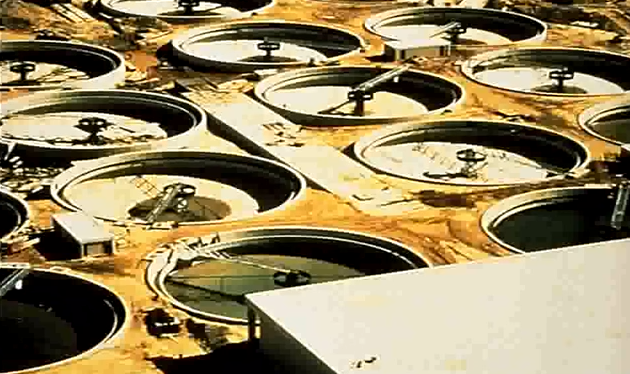
POTW
The other side of the road but the key is that it’s flowing from a pipe. You’re right it depends on what is on the other side, if it’s just forested area it would be a non-point, But it’s coming through a pipe so that actually determines that it is a point source if that upper side of that is for instance a municipality or the Denver Federal Center. So just seeing it coming out of a pipe coming towards that point source side depending on what’s up there.
POINT SOURCE
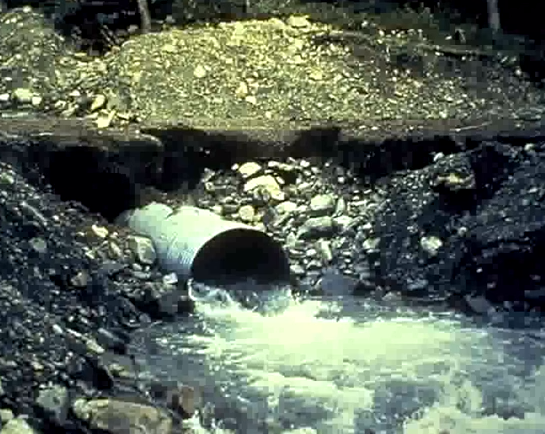
POINT SOURCE
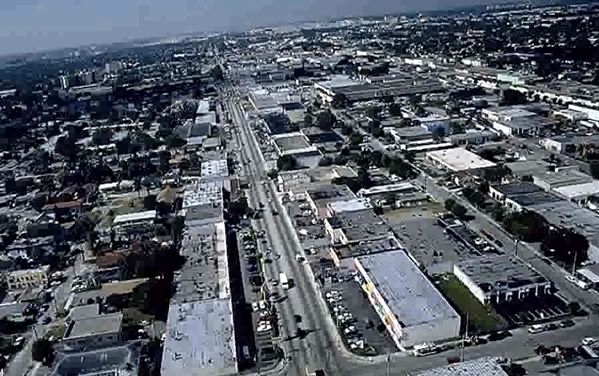
It is a point source, all municipal systems have control over their rainwater runoff and so that is now a point source. This has actually been challenged recently in court in California, LA County is challenging whether they should be considered part of the point sources and this is gone to the Supreme Court and the decision was that they are responsible for the runoff off from their surfaces. They are now a point source so everything that comes off of that even though it’s distributed so some people think that well it’s distributed all over the place, it’s a non-point source. It actually is still a point source because a municipality has a permit to control that.
POINT SOURCE
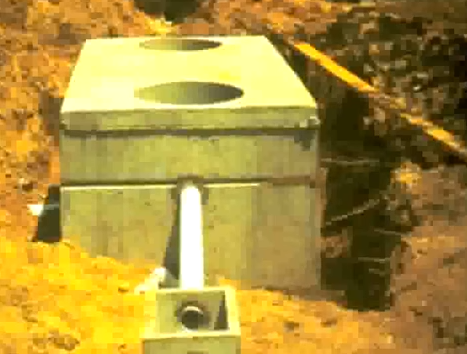
How about this? Doing some development? That is a point source, even though it’s distributing maybe some new development there that is still considered a point source.
POINT SOURCE
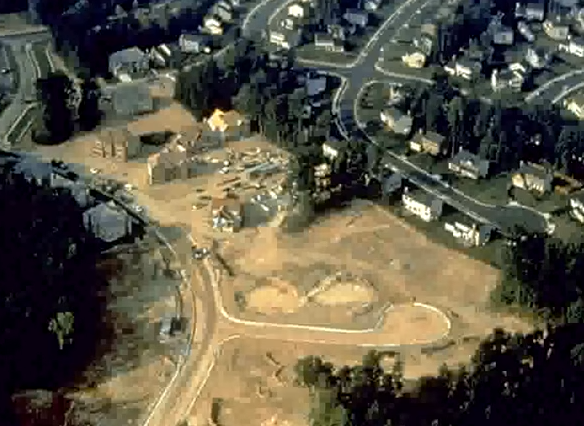
NON-POINT SOURCE
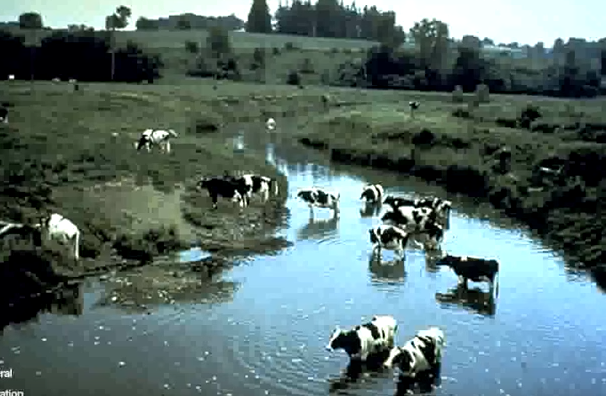
Why? Agriculture
That one; same thing, non-point source.
NON-POINT SOURCE
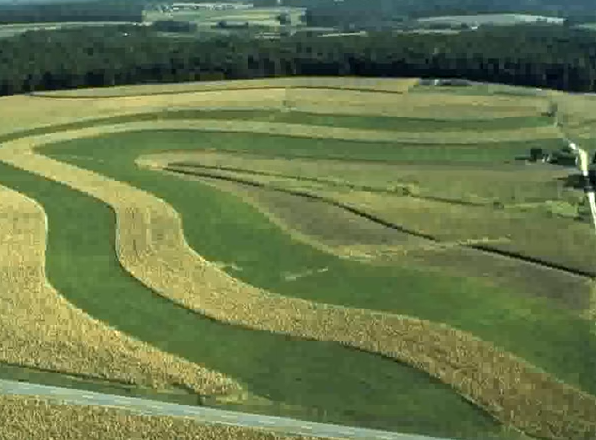
Although I’ll tell you right now that they’re looking at regulations to start not permitting this but to regulate runoff from agricultural sites because they have found that…As anybody heard about the problem in the Gulf of Mexico and the anoxia, the lack of oxygen in there? A lot of it is attributed to agricultural within the Mississippi, Missouri and Ohio watersheds that is bringing all that pollutants essentially down to the Gulf of Mexico and it uses up a lot of that oxygen and the next thing you know you have fish kills and so forth down there. So it’s called the dead zone for the part that has very little oxygen and its shrinks and grows and so forth yearly.
Who would be regulating this? It would be the EPA, what they’re actually trying to do is not regulate the farmers, what they’re trying to do is promote best management practices to be able to regulate or to be able to treat the water that’s running off from agricultural fields. So in our original design and you will see this in a minute. We like to make our rainwater systems very efficient get the water off, get it into the stream. Same thing with the agricultural system, we put all that tile in there right; so anybody grew up or worked on farms? Didn’t you go down and put the tile in there to make sure that that you get your wet spots and it drained to whatever drainage ditch you’re going to, so it worked pretty well. Well where finding out that maybe that efficiency is not so good.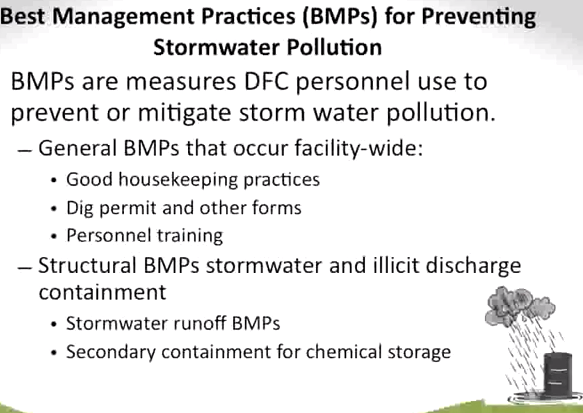
Let’s mention these things; best management practices, BMP’s and really what we’re trying to do is prevent some of that rainwater pollution from reaching our waterways. So when we do this we are really looking at you guys because you really are the first line of defense. Especially contractors etc. you guys are seeing this stuff day in day out there and we’re trying to encourage you to use good housekeeping practices, when you’re digging, getting the permits and filling out the forms. Personnel training and we call those types of best management practices nonstructural because were not building anything. We’re learning about it, we’re doing things like that educating people and then we have structural BMP’s which are the things that we build or put in the ground etc. We’re talking about the actual rainwater BMP’s that we put in for post construction, during construction. And then we have or secondary containment for chemical storage things like that those are also structural types of BMP’ A lot of people are like what’s the big deal it’s been raining for eons and; why is rainwater problem?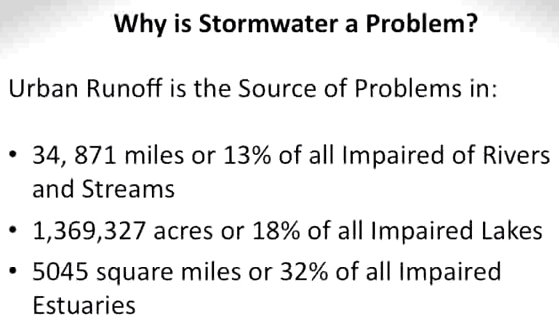
If you look at this across the nation over 34,000 miles are impaired and often times it’s from rainwater runoffs. So are going to be located mostly around our urban systems, over a million acres of all Lakes are impaired. Do you know even right around here we have some impairment in our Lakes or Reservoirs, Cherry Creek, what is its impairment?
They’ve got some Mercury but they actually have what they call a TMDLR it’s an annual maximum daily load or annual maximum daily load for phosphorus of all things, we’ll talk about that a little bit too. And then of course estuaries, we don’t want to worry about estuaries here in Colorado.
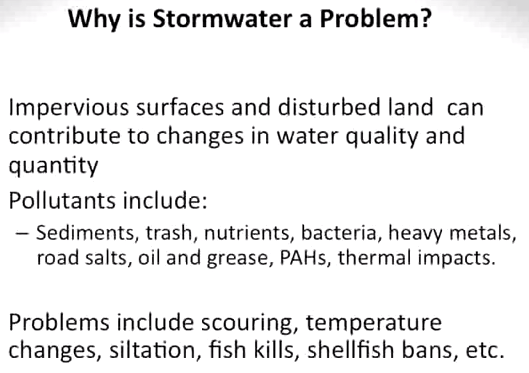
One of the causes is that often our impervious surfaces. The water comes down and depending on where you are or the types of soil it either soaks in, maybe soaks in a little bit and then runs off. But that runoff once we develop that and we put a parking lot or a rooftop or something like that it can’t hold any water there anymore. And we even designed ours with crowns in the road etc. to get the water off fairly efficiently and into our waterways. When it runs off we can have things like trash, heavy metals which a lot of people don’t realize that our brake pads and so forth have heavy metals in there. Every time we apply our brakes a little bit of that dust is hitting onto the road. When we get that next rainfall event it takes those little particles and takes them to the stream. That’s the kind of stuff that we’re not worried about but think about in terms of developing best management practices to help reduce that. And then I’d mention some of the problems, one of the biggest problems with having those impervious surfaces and developing areas is that we have to put some kind of BMP in there to treat the rate of runoff. Because sometimes it’s really hauling off those impervious surfaces and that can cause scouring of our streams. In Denver a lot of different places and you see these stream banks that are vertical and they are this high and you can see the stream cutting down that’s called scouring. You end up seeing the stream bank sometime slumped into it. That’s really the stream trying to equilibrate with that volume and rate of runoff and that causes all kinds of other problems with the silk and dirt that runs down the stream and then we can get fish kills.
